[Atari, Free Fall Associates]
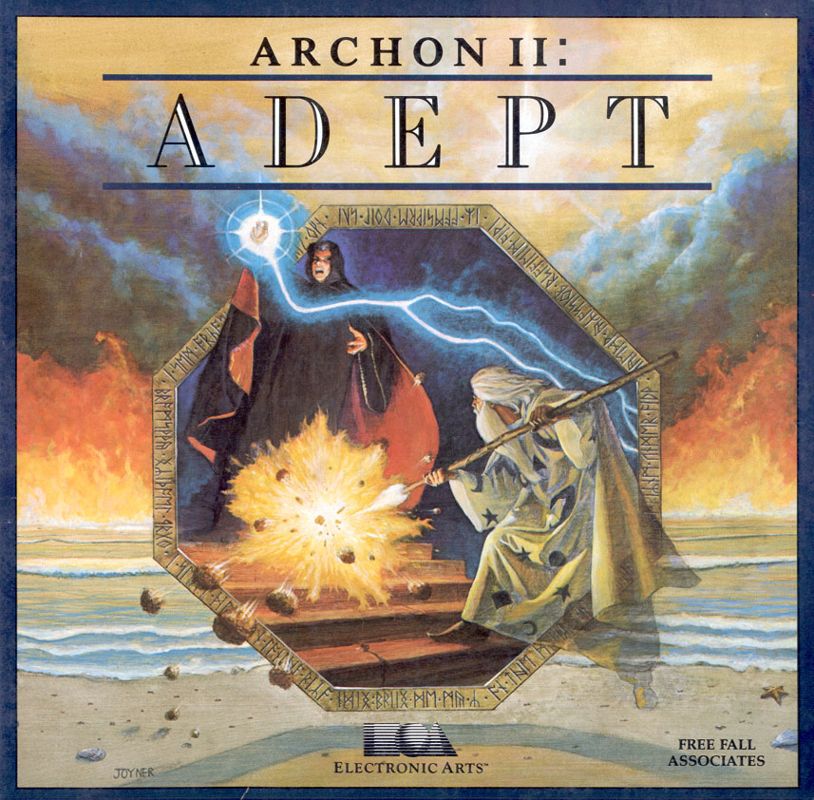
There are the strategy-flavoured action games that I feel I have to cover because they’re so popular and then there are the strategy-flavoured action games that I feel I have to cover because they are the sequels of games in that first category. Archon II: Adept belongs to the second category.
Where Archon featured a 9×9 but otherwise typical chessboard, Adept opens on a more Ultima-esque scenery: 2 groups of 4 Adepts are lined up behind their castle, each of them standing in a different Plane: Earth in the centre, then Water, then Air, then Fire. Six power points flash in white: 2 in the black “Void” squares and 4 currently in the corners of the plane of Fire, but each turn the latter will move from plane to plane until they reach the plane of Earth, after which they will return to their starting locations. Unlike Archon, the power points in Adept are means as much as ends because controlling them ensures a steady flow of magic energy which will be used to cast various spells. Like in Archon, controlling the 6 power points at the same time still triggers a victory, the most convenient way to win the game is to prevail during the Apocalypse, during which the two castles will fight a final duel to the death, with their stats depending on the board situation when their battle commence.
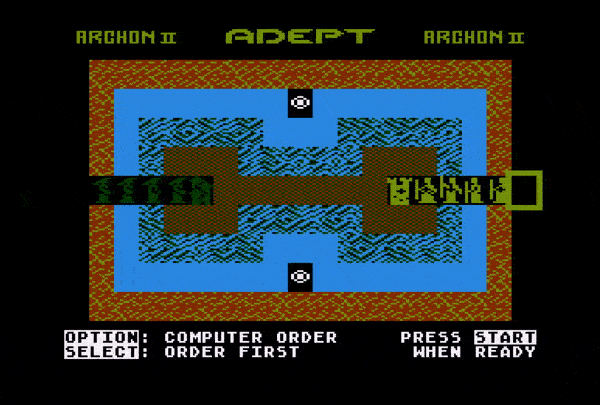
Once again, I lead the force of Chaos, though this time the map does not shift between light and dark so the only difference is the set of creatures that can be summoned – but more on this later. As the game commences, I don’t summon anything because the only good opening move (in my opinion) is to occupy the power points with the Adepts. They could be occupied with summoned creatures, but these have both a summon and a maintenance cost, while the Adepts only have a one-off movement cost – so no reason not to use them.
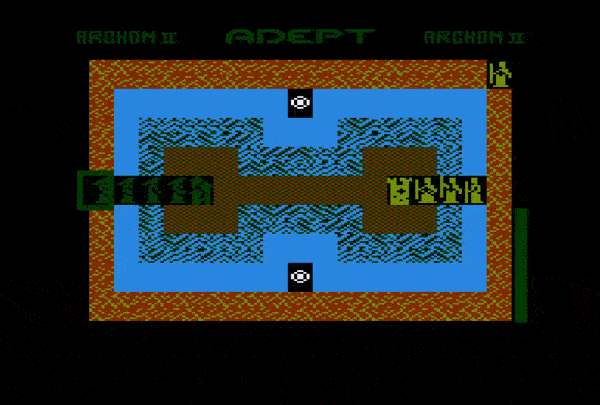
After this prologue, the action starts in earnest. Order summons a juggernaut (a “demon”, which is a type of creature available to both players) directly on a Fire power point. I like this, because the Fire Elemental of Chaos, the firebird, is a hard counter for the juggernaut: the juggernaut attacks by charging, and the firebird attacks by engulfing its surroundings into flames, which also makes it immune to attacks. With the bonus in health for fighting in its own element, I easily prevail in this opening battle.
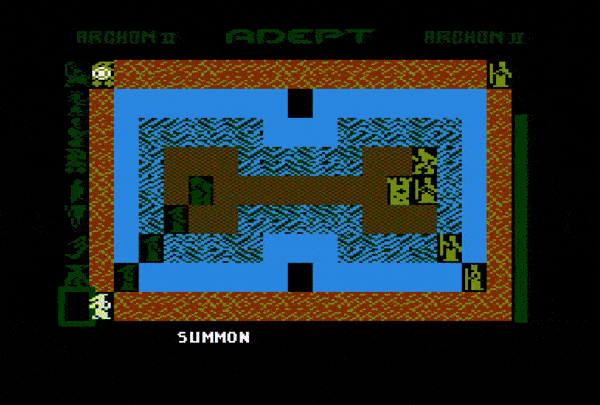
The Adepts of Order then allocate several turns to summon various creatures to occupy the corners of elemental planes. On my side, I summon my Elementals of Air (the efrits) to occupy the void power points: they yield only half of the energy of an elemental power point, but every turn instead of every four turns.
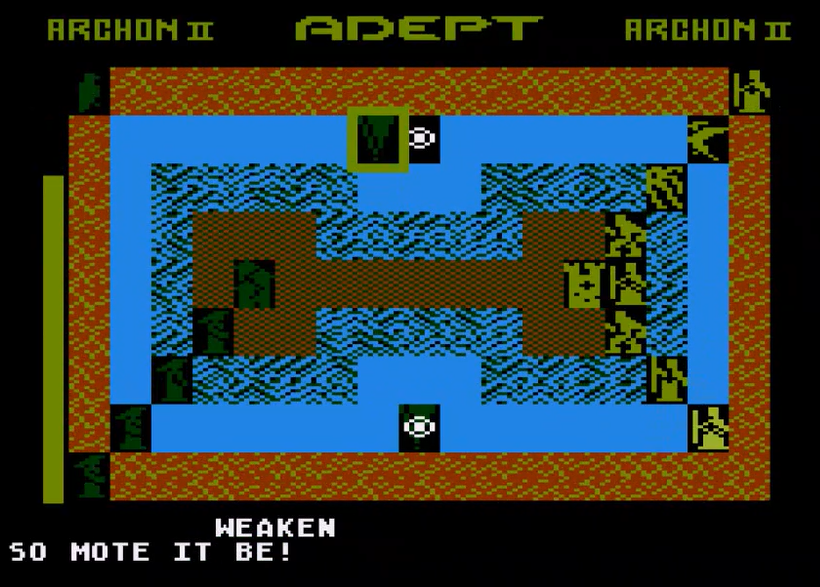
Jealous of my superior revenue, an Adept of Order teleports straight into the void and faces my efrit. The AI never misses with the steerable magic attacks of the Adepts, but my efrit shoots faster and I hit the Adept twice, winning the battle.
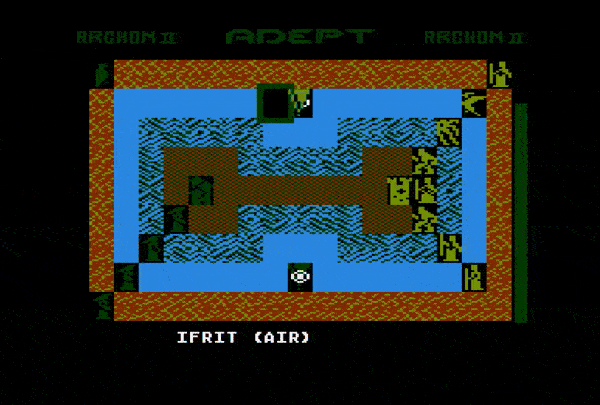
The vanquished Adept came from the plane of Earth, so Order cannot directly summon anything there. I exploit this opportunity by summoning a gorgon (a demon available to both sides) and destroying its two giants (the Order Elementals of Earth). Giants have a lot of health points, but gorgons don’t care: instead of inflicting damage, they slow their opponents until their death. The giants start slow already and only two hits are needed to destroy them.
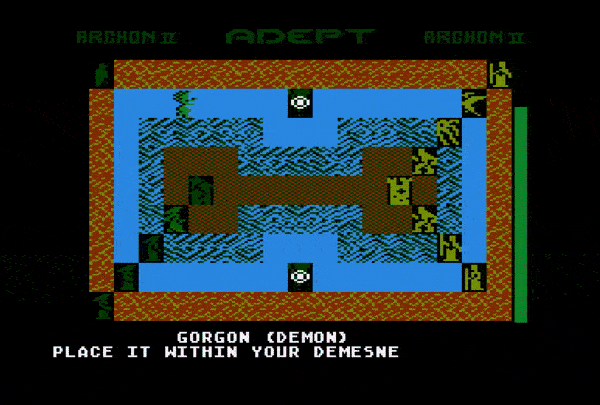
Meanwhile, Order sends another Adept to finish off my wounded efrit on the void tile, and destroys two others of my summons with its own gorgon – the AI knows how to use them. The back-and-forth carries on for some time: there are some creatures that I easily defeat, others like the nimble thunderbirds are too powerful when in the hands of the AI and I try to avoid them or destroy them with a costly Banish spell.
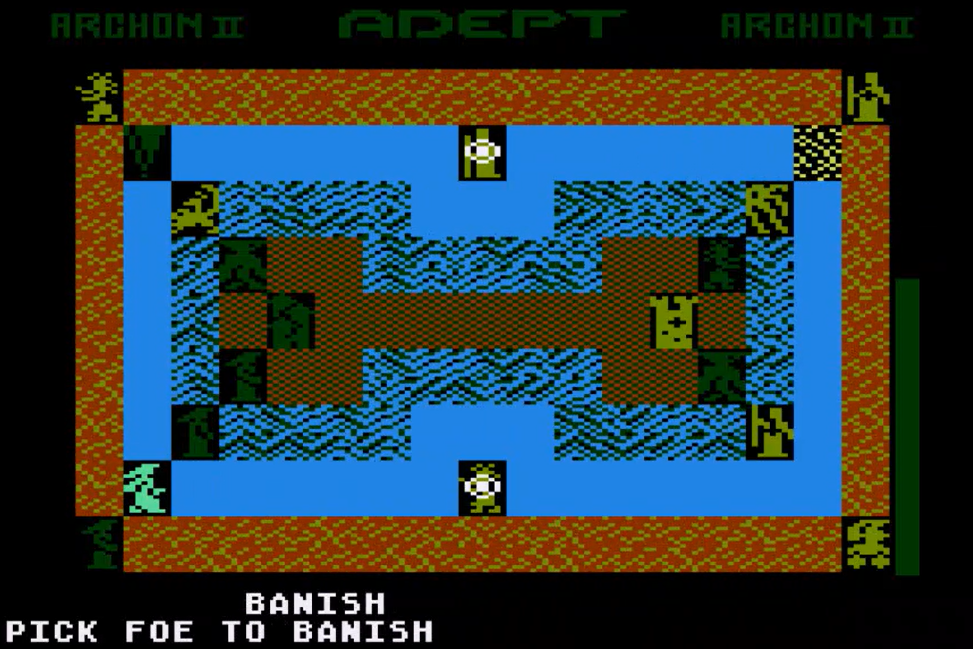
Luckily for me, the Order frequently summons creatures that are easy to counter (the predictable juggernaut, the slow kraken or the gimmicky chimera) and I slowly accrue my advantage, until I can afford to send another efrit to the void, killing a second Adept of Order.
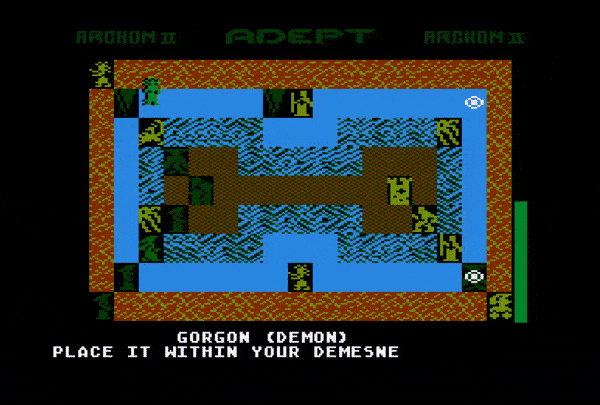
I have a decisive advantage, and over time I kill the two remaining Adepts of Order, always with efrits in the obstacle-less void – I never managed to kill an Adept in any game with another creature.
The destruction of the last Adept of Order triggers the Armaggeddon, and the two towers turn into Wizards. Their health depend on the energy of their faction at that moment, and sadly I was all out. On the other hand, the damage depends on how many units were on the board, and there I absolutely dominated order, so I hit like a truck. Still, a Wizards fights exactly like an Adept, so the AI never misses a shot:
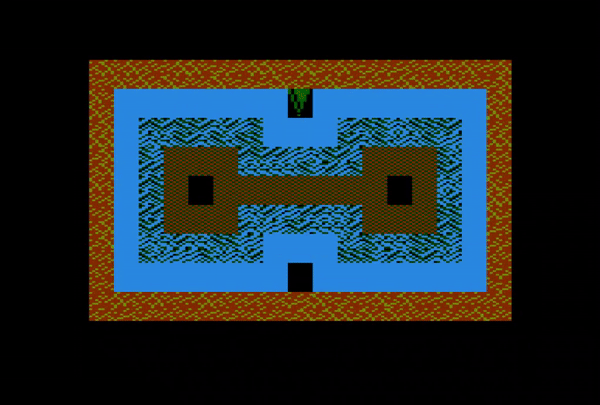
I manage to win with one line of pixels left, barely ending the game on a victory.
Rating & Review
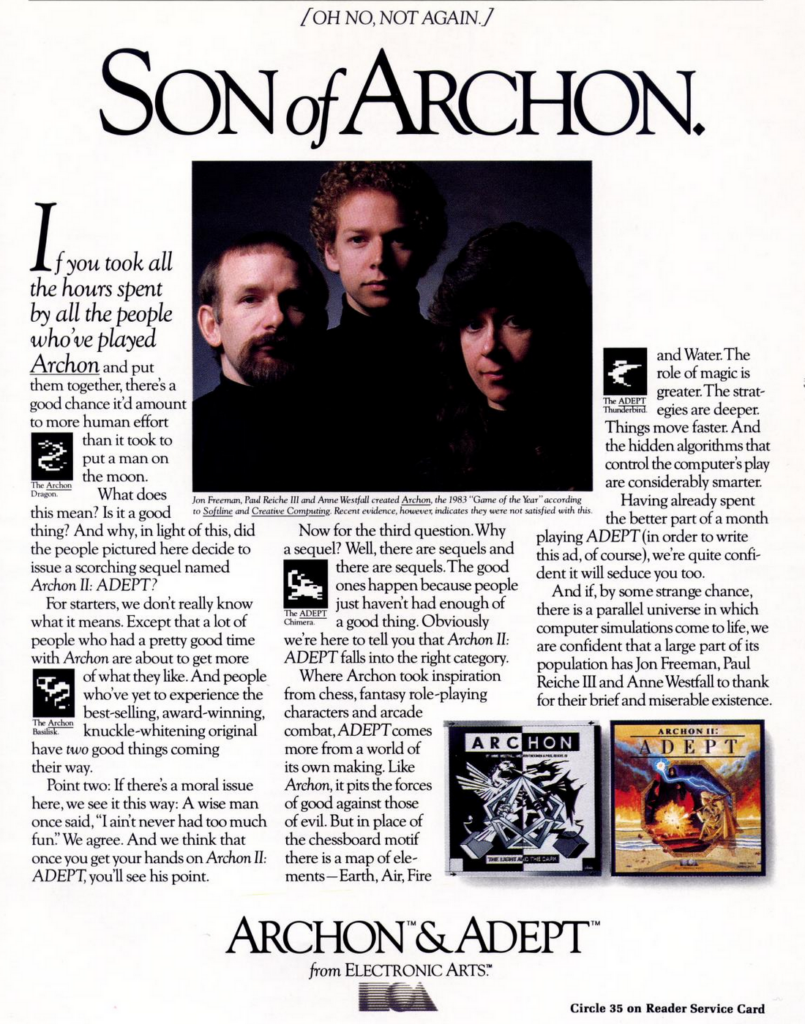
Archon II: Adept by Free Fall Associates, published by EA, USA
First release: August 1984 on Atari and Commodore 64
Genre: Action Strategy
Average duration of a campaign : Very variable. You can cast Apocalypse turn 2!
Total time played: 2.5 hours
Complexity: Low (1/5)
Rating: Two stars
Ranking at the time of review: 26/141
Context – Archon‘s runaway success in 1983 left EA’s founder Trip Hawkins hungry for more, particularly as he had personally fallen head over heels for the game, and Free Fall Associates (co-founded by Jon Freeman and Anne Westfall) soon received pressing requests for a sequel. Freeman claims he never imagined making a sequel: “But in our wildest dreams we did not anticipate a sequel when we created Archon. It was just not the kind of game that suggested to us a sequel. We didn’t want to just do the same game with a little teeny bit of difference and then resell it.“, but eventually the opportunity was too good to pass and Hawkins too influential to ignore
When Freeman, Westfall and designer Paul Reiche III finally started working on the sequel, they did everything they could to make it as different as possible from Archon I while still being Archon: the tactical layer was hard to modify without losing the DNA of Archon, so the strategic layer took the bulk of the changes: no more chessboard, no more light & dark (instead: chaos & order – subtle, isn’t it?), even the logic of “movement points” on the strategic map was removed. Starting from a blank canvas, they designed something new around some of the most common feedback they had received: players wanted “to be able to build your own armies, to play some of your opponent’s types of pieces, to use magic spells more often, and to limit the edge given to players who happen to be agile with a joystick“. All the pieces soon fit together: if you want to build your army, this means there needs to be a currency to summon them, so now there is a magic energy system which allows players to cast magic spells more than once. As for “limiting the edge” of the best players, the new roster was expanded, with different units now addressing different playstyles and skill levels, some of them easy to use but with limited potential, others hard to master but powerful in good hands – or at least that’s what Freeman claims about the chimera, but I would press X to doubt.
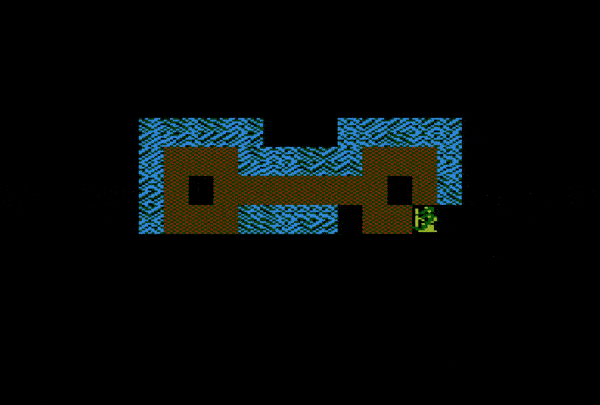
Adept was initially released on Atari and Commodore 64 in August 1984 for $40. It was subsequently ported to Apple II, ZX Spectrum, Amstrad CPC and Amiga. The Atari and Commodore 64 versions are similar, but the ports are all over the place. The Apple II port is acceptable, but there was no effort on graphics and the cursor flickers irritatingly. Both the Spectrum and the Amstrad CPC versions are slow, and their AI horribly downgraded – in particular it walks into fire tiles as if they were not there. The only “good” port is the Amiga one, a computer on which EA put special efforts and which eventually became the most successful version.
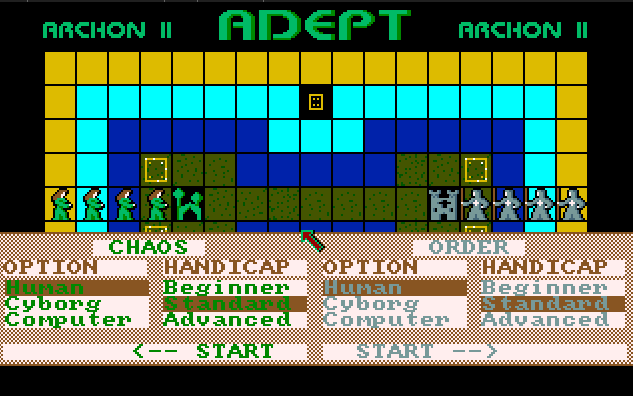
Traits – On the arcade layer in abstracto, there is in my opinion no contest that Adept is Archon, but better! Archon had only 3 types of units (melee, “explosion”, and range), with the ranged attacks only varying in terms of speed, damage and shape of the bullet. Adept introduces dash attacks (juggernauts), AOE attacks on the whole map (syrens), paralysing attacks (gorgons) and aimed missiles (adepts), in addition to various special rules for the creatures themselves like the invisible wraith. I also appreciate the five different battlefield types in Adept: the void is empty, fire damages you, water slows you down, earth blocks you fully and air redirects the projectiles.
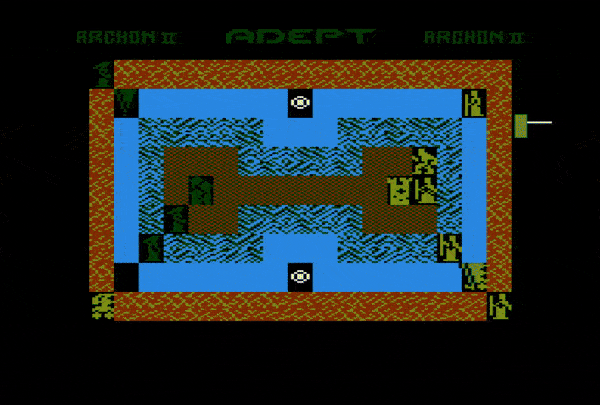
My issue with Adept is the strategic layer. Free Fall Associates took some significant risk by ditching the chessboard and replacing it with a creation of their own, reminiscent maybe of a twelve men’s morris board. It did not pay off: while the board is beautiful in its symmetry, it is singularly underexploited: what’s the point of all those tiles when movement within a plane is limitless for ALL units. With unlimited movement and the capacity to summon anywhere in a plane provided the summoner is also in that plane, the strategic layer is not about spatial control but about logical control. The only interesting tiles are the 12 corners, the 2 void tiles and the 8 tiles leading to the latter – the other 127 tiles are dead, only used occasionally as unit storage. Whoever ported the game to the European platforms did not miss this: the ZX Spectrum and Amstrad CPC ports altered the layout, presumably to adapt the game to the screen ratio, and it does not have any gameplay impact.
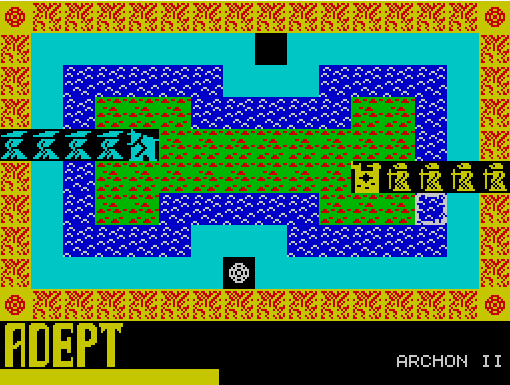
Another design choice of Adept turned out to be a weakness. In Archon, you started with an army that could only go down in size, so if you killed one of your opponent’s key creatures it would be gone for good (well, it could be resurrected, but only once). By contrast, in Adept you can summon any unit provided you have the mana. Some creatures counter others, but there are a few creatures at the top of the pecking order that counter most other creatures and have no counters themselves: the efrit for Chaos, the salamander and the thunderbird for Order – and nothing stops you from summoning them again and again, directly on your opponent’s creatures if you need. I haven’t played against human players, but against the AI I only found a niche for 3 units (the firebird, the gorgon and the efrit), and even then I could probably have done without the gorgon. I suspect that in multiplayer, the roster is even more limited – it’s fun to play against a chimera or a kraken, but the computer is the only one to use them.
Finally, speaking of AI, I must mention a final flaw of the game. By design, you must be able to beat adepts, because they are the core units of each side and because the final Apocalypse battle is an adept-vs-adept battle. If you are not able to kill an adept, you will never ever win a game against the AI. Alas, the AI cheats with them: their missiles are nigh impossible to steer as a human player, but for the AI they are homing missiles that never miss, only giving you a few seconds to wound or kill the AI. It is incredibly frustrating.
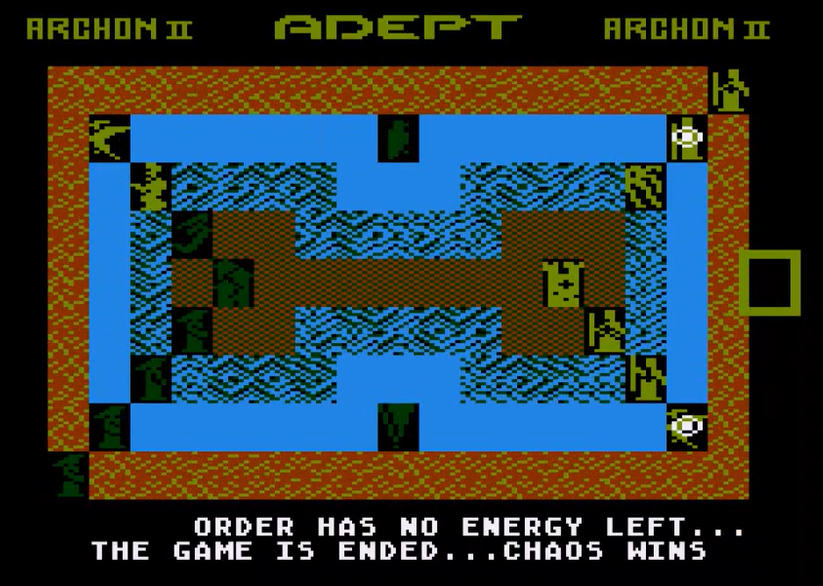
Did I make interesting decisions? Not really. I learned which creatures to use in which circumstances and how to play the arcade part of the game.
Final rating: Two-stars. Archon II: Adept looks and plays like Archon I. The arcade part of the game is better, the strategic part is worse, and since I value the latter more than the former – and also to be honest because I am still miffed at those homing missiles – I ultimately rank Adept immediately below Archon.
Reception
Just like Archon, Adept received dozens of reviews, most of them excellent. I did not keep an exact count, but probably half of them claim Archon II is better than its predecessor, for instance ROM Magazine (“Archon II: Adept” is a much improved upon version of Archon“) or Compute! Magazine (“In 1983, Archon ranked at the top of almost every gamer’s list. It still belongs in the videogame hall of fame. Archon II: Adept is even better than Archon”). The rest of the reviews generally consider Adept more or less equal to Archon.
Given this, it is surprising that Adept, while successful in its own right, was evidently less so than its predecessor and released on fewer platforms (6 against 10 for Archon). More decisively, while Archon received almost cult status, Adept is barely a footnote in the history of gaming. Patrick J. Kelley, writing for Analog Computing, has the exact words for it. While recognizing that Adept is “conceptually” the better game, the satisfaction of playing the worse one is superior:
“Thus, you’re not battling individual pieces as you were in the original Archon, where victory depended on your skills in attrition against your opponent’s pieces. Instead, you are battling “power,” a concept I feel falls flat when compared to the original. Surgically eliminating pieces cannot give you the same gain as in the earlier version, let alone the satisfaction of splattering an enemy to the four winds.“
I also believe Adept had a weaker appeal: Archon could be pitched in an elevator going from the first floor to the second floor; you could show it to friends who never saw the game and they would immediately get it. On the other hand I had to explain the core rules driving Adept in a long paragraph and then spread out more explanations in my AAR – it is not pick & play like Archon was!
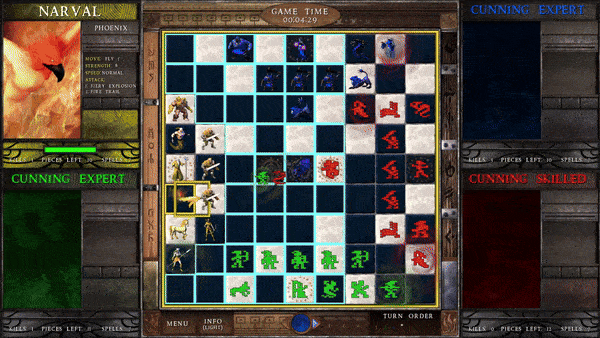
This is probably the last Archon I cover – Archon Ultra (1994) is Archon with a new engine and an extra ability for each unit so I am unlikely to spend time on it, and I don’t ever expect to reach Archon Classic (2010). Anne Westfall and John Freeman are unlikely to reappear on this blog as developers either, given their one remaining non-Archon PC game will be the intriguing RPG Swords of Twilight (1989), which was somehow missed or skipped by the cRPGAddict. However, Paul Reiche should return often, starting in 1985 with Mail Order Monster.